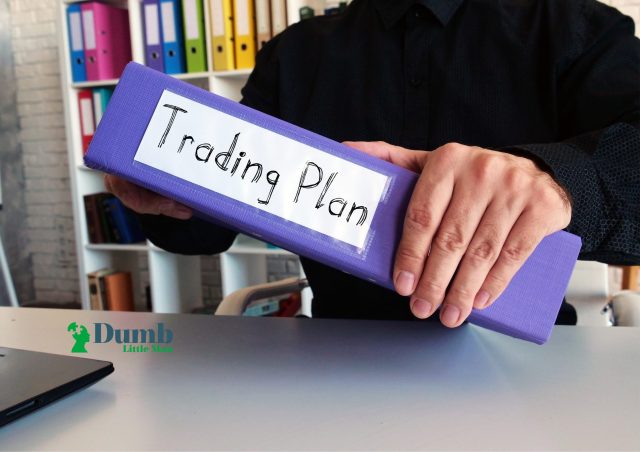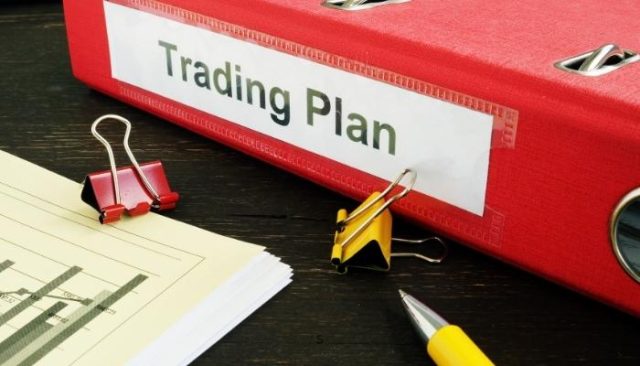Developing The Perfect Trading Plan? A Beginners Guide (2024)
By Jordan Blake
January 10, 2024 • Fact checked by Dumb Little Man

Want to jump straight to the answer? The best forex broker for traders is Avatrade
The #1 Forex Trading Course is Asia Forex Mentor
Life comprises of so many plans. And the plans are part of human efforts to achieve goals set within particular timeframes. So, with plans, trading is also not an exception. Human beings are wired to work with plans.
If we narrow it down to trading, good plans can take you to the best trader – with huge profits. On a contrary note, failing to have trading plans is a recipe for losing money very rapidly to the markets. In fact, some scholars often say that – “Failing to make plans is a plan to fail.”
We’ll dedicate this post to the purpose of explaining a perfect trading plan. So, we’ve made efforts to tap into the expertise of Ezekiel Chew – a trainer, trader, and markets analyst with more than 2 decades of expertise in the financial markets.
As part of the overview, readers should look for the 9 key components of a good trading plan. One key section will pull emphasis why every serious trader needs a trading plan. And to wrap up are two frequently asked questions on the topic.
What is a Trading Plan?

A trading plan usually shows the key steps. It’s a simple set of procedures to follow while validating market analysis and trade management. It aligns your goals and helps you tailor your interests.
With a trading plan, you use it as a checklist against the prevailing market. It helps you know if you should be in the market or keep off. A basic trading plan should help you answer the following:
- What is your goal as a trader?
- What is your trading style?
- How do you manage trade risks?
- What are your must-meet conditions for you to open positions (Others refer to them as trade confluences)?
- Plus, what expectations do you have with trading?
Experts say that your trading plans are in summary, your expectations as a trader. The plans should have clarity on how you will achieve them and the areas you require to work on towards achieving your sets of goals as a trader.
Since every trader creates the plan, they should specifically make suitable choices – which should also be a reflection of trading interests.
A good number of traders also take the trading plans a notch higher, they take them as plans to hold themselves to account. By holding themselves accountable, they focus more on following every rule they've set.
Overall, being able to make rules and follow them instills a very high level of discipline. It’s a critical ingredient for most successful traders.
9 Things You should see in a Trading Plan
This section will go over the key components of a credible trading plan. Ideally, traders can take on this as a template to start off and keep improving. Traders should feel free to make very adjustments that suit their unique trading scenarios.
Every good trading plan consists of:
#1. Your Motivation as a Trader

Every trader gets onboard with some targets. The emphasis is on making tweaks to enable a trader to come up with a very specialized plan. One key pointer is the reason that clearly motivates you. Further, a trading plan needs to be clear on what your targets are as a trader.
There are two reasons why a clear purpose for motivation. Firstly, let it be very clear regarding the sources of your motivations. Secondly, it should be clear as to why you keep trading. More so if it happens you are losing significant amounts of money trading.
#2. What Goals do you have as a Trader?

Basically, this clearly spells what your intentions are from trading. Could it be just for the interest of learning how to trade? Or looking for financial freedom
Others may be looking to earn a few bucks along the way. Yet, others may be targeting a full-time career in trading. You could also approach it from the point of how much you need to earn on a monthly basis.
Most importantly, a trading plan serves as a trading manual. For purposes of following all the rules, you need to make frequent reviews and follow-ups.
Trading goals are a key starting point when looking to decide on a trading system. Also, one key component of winning in the markets arises from the number of preparatory efforts put into the decisions.
The simplest way to list the aims in trading is to be direct and specific- it helps with deciding on a trading strategy. The simplicity here helps with clear definitions of expectations. Plus, the clarity helps refine your trading strategies by aligning them to the goals you set.
Here’s a list of my goals with trading:
- Make profits amounting to $5000 per month
- Learning more strategies for scalping
- Limit my trading hours to 5 per day
#3. Amounts in Capital Available for investment

One tactical way to approach a trading plan is to include the amounts of capital ready for trading. Trading is usually addictive. So be clear on your amounts on a daily, weekly, monthly, or annual amount.
The basis here is to move away from the false promise or poor financial decisions that you can make millions from home
Ideally, having a cap offers limits. Plus, your money has other purposes – settling bills like rent and energy. It’s disadvantageous to trade without limits.
First, trading without capital limitations, you pay less attention due to the notion that you have limitless access to capital. Caps or limitations help with minimizing excessive losses.
Secondly, trading without a cap may lure you into losing too much money without you noticing it. It’s one common mistake many novice traders make. Blowing many accounts, with however small capital is and flag. With a cap, you are already sure how much you stand to lose in units of time – monthly or annually.
#4. What Target Markets to Trade on

A good trading plan is personal – it gets down to the markets in terms of the commodities, indices, or forex currency pairs you trade.
And the best way to be a tactful trader is to concentrate on specific markets. It’s easier to focus and learn the skills by dedicating time plus resources. It is easier to create more focus on a few markets than to chase everything.
As part of making a better strategy, a trader can narrow down to only markets in which they have good results. Getting deeper into it, more technical analysis will help you spot what variables cause huge moves in a specific market.
A good example of specialization is narrowing down to either the EUR/USD or GBP/USD. Next, focus on the patterns that work, bearing in mind that the USD is the quote currency.
#5. Clear Rules for Entry and Exit in Trades

Purely, these are common rules for opening and closing trades. You may also refer to them as confluences. These could be sets of indicators to strategies you’ve done back-tests on. Also, chart patterns or shapes of candle sticks may form part of the rules.
A good trader follows the set conditions for the confluences. Traders can have several. If you stick to a particular candlestick formation – you trade by that.
#6. A Clear Trading Style

Out of several trading plans, your trading style aligns with where you score the best results. Look out for the entries/ exits, and profitability versus risk management while fine-tuning a trading style.
Here are some common trading styles where you can find the best fit:
Day Traders
Day traders open and close trades within a day or less. Most important, no trades cross over to the next day. They can do several trades within a day.
Scalpers
The scalpers open and close trades quickly – usually within minutes. With each trade, they close with small profits. It's common with sellers of securities in stock markets.
Swing Traders
Swing traders hold trades for relatively longer – a few days to weeks. Some go for a few months.
Position Traders
Position traders are long-term traders running from months to years.
And back to the focal point – the creation of a trading plan should be as specific as possible. So, some of the key technical information to come out clearly is:
- Trading timeframes
- Indicators
- The stops and limits to use
- Tools to trade
The above four points help by making a trading strategy very easy to use. In form of a hint, all a trader needs are to use each as a guideline before opening any trade. Additionally, the most critical point is to fit your trading style into the trading plan.
Lastly, see if your trading plan is affected by:
- Capital available
- Time available
- Market research done
- Overall performance
#7. Management Risks

Risk management should be a significant portion of the trading plan. The entire question of avoiding or minimizing risks is a key ingredient to managing trades. Ideally, sound risk management is at the center of the profitability of every trading plan.
In that order, the trading plan you adopt should have sound clarity of protecting capital, and taking adequate profits into account growth.
Next, we’ll look at several risk management strategies – which you can adopt as a component of a solid trading plan:
Adopting a 2% Rule
Traders who adopt the risk management following the 2% rule, never risk more than that for any trade or trades at any one time.
While this rule is not cast in stone, traders can have flexible percentages. The critical here is to follow it without breaking the rule you set for yourself.
Ideally, the percentage goose is in line with an individual trader's level of risk tolerance.
Risk- Reward Ratios
This risk management strategy simply proposes a set ratio of risk in comparison to the prospective reward for any trade.
Therefore, the ideal situation is to exit trades at the right instances under the rules of your personal trading plan.
To grasp the correct risk-reward ratio for your case, it’s best to derive that from records you’ve kept over time. From them, analyzing though you can see patterns and the respective market scenarios as starting points.
#9. Clear Schedules of Trading
Agreeably, a good trading plan has a schedule. And it’s a simple timetable. To help yourself, work with one you can follow strictly. To win consistently treat trading with no less seriousness than you would for a 9 – 5 job. Assume you report to the markets in the morning and leave as others in the evening.
One other great hint is allocating time to update your skills. So slot in times for tutorials, courses, reading books, or blogs/Vlogs. It’s in the spirit of investment research to stay up to date, plus keep improving things for the better.
Why is It Important to have a Trading Plan?

To set records very clearly, a trading plan is a tool every serious trader must have in place. Here are among the benefits you gain from having one in place:
The Discipline of a Trader
A trading plan keeps a trader with focus. You follow the rules you set for yourself. Since it’s a contract with yourself, you are accountable to no one else, but to one’s self with a tactical trading plan.
Rules on Money Management
As seen above, every trading plan comprises trading tools, and more importantly – how to reduce exposure to risks. With clear plans in place, you place yourself into a tight focus on successful trading. Else, a lack of plans makes traders make random decisions – including taking poor investment advice.
Time Management
Your successful trading career builds on correct time management. Ideally with a schedule that guides on what to do at particular sessions. There’s analysis, actual trading, and making progressive reviews, among other tasks.
Best Forex Training Course

There is no doubt all these things may seem a bit technical to follow. In fact, the price makes so many wild swings each day that it can be very hard to measure buying pressure or selling signals. Also, learning all the technical analysis you need for forex takes more than just a day. Instead of relying on the odd article here and there, you may want to get a full detailed course to take you through all these situations.
Here is where the idea of the Asia Forex Mentor by Ezekiel Chew comes in. The course is a comprehensive course from beginners to advanced that will give you the knowledge you need to trade forex. It's a beginner-friendly guide as well that works for folks who want to trade forex and any other financial asset.
The Asia Forex Mentor will not just teach you how to predict price shifts, daily volume, and these other technical indicators. It will also teach you how to manage capital and explore some of the most advanced risk control measures in the world. After all, as long as you are managing your capital correctly, identifying overbought and oversold pairs will be the easier part.
Also, if you are an advanced trader looking to learn some of the tricks used by leading banks, this course is also ideal. As a matter of fact, The Asia Forex Mentor is developed by someone who has taught some of the leading investment bankers how to trade forex. You will be able to identify a losing trade, gauge price movement under immense trading pressure, and maintain a level head even when the markets are volatile.
| RECOMMENDED TRADING COURSE | REVIEW | VISIT |
|---|---|---|
 | #1 Forex, Crypto and Stocks trading course. Ranked most comprehensive by Investopedia and Best by Benzinga. Free to Try! |  |
Best Forex Broker
| Broker | Best For | More Details |
|---|---|---|
 |
| securely through Avatrade website |
Conclusion: Trading Plan

A trading plan is a roadmap that entails all the significant components a trader requires to survive the markets. It helps make things simple, from random to clearer decision-making.
Trading plans are living documents, allowing for constant reviews, learning, unlearning, and re-learning as markets change. It helps you preserve capital and minimize risks. No external parties have authority over it, including the commodity futures trading commission
With a trading plan in place, traders know what steps to take next. To jump out of the market or allow more breathing space for active and winning trades.
Lastly, it’s the tool that sets, for discipline, time, and risk management reading from past performance in a forex market.
Trading Plan FAQs
Should a Trading plan be permanent?
Never. This should be a living document that you adjust over time as you learn new concepts and strategies to minimize risks and secure profits to grow your accounts.
Since market conditions change, it places traders in a position to always change tactical trading plans and investment strategies to suit what works for them.
Can I trade without a trading plan?
Yes, a trader is free to trade without a plan. The unfortunate thing however is the downsides are so devastating. With a plan in place, traders have a starting point to explain why the losses are more than profits.
Trading plans help you evaluate the results of trading history and stay tuned to pointers for improvements over time.
Jordan Blake
Jordan Blake is a cultural commentator and trending news writer with a flair for connecting viral moments to the bigger social picture. With a background in journalism and media studies, Jordan writes timely, thought-provoking content on everything from internet challenges and influencer scandals to viral activism and Gen Z trends. His tone is witty, observant, and sharp—cutting through the noise to bring readers the “why” behind the “what.” Jordan’s stories often go deeper than headlines, drawing links to pop culture, identity, and digital behavior. He’s contributed to online media hubs and social commentary blogs and occasionally moderates online panels on media literacy. When he’s not chasing the next big trend, Jordan is probably making memes or deep-diving into Reddit threads. He believes today’s trends are tomorrow’s cultural history—and loves helping readers make sense of it all.













